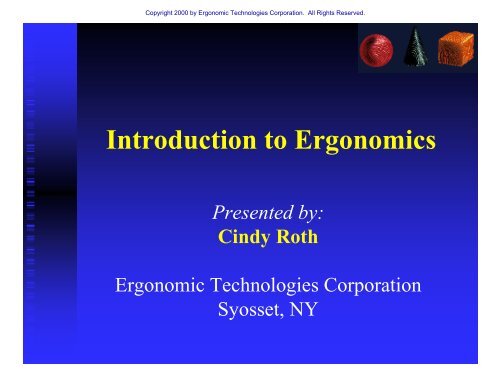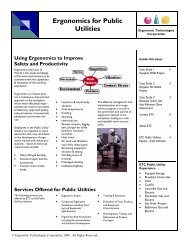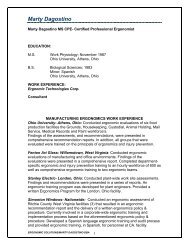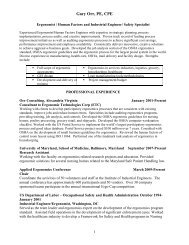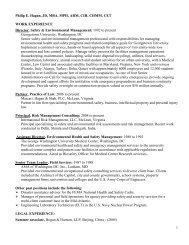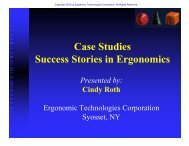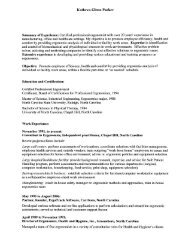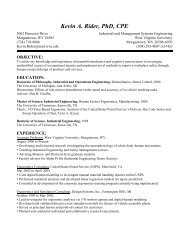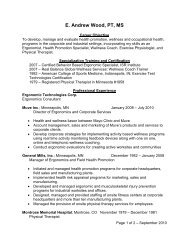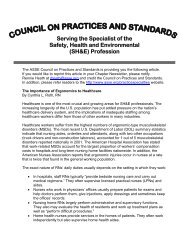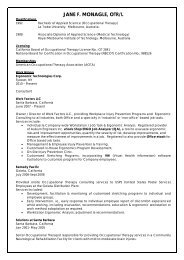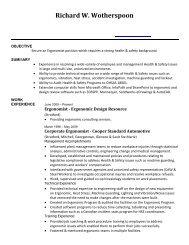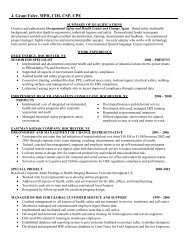Introduction to Ergonomics - Ergonomic Technologies Corporation
Introduction to Ergonomics - Ergonomic Technologies Corporation
Introduction to Ergonomics - Ergonomic Technologies Corporation
Create successful ePaper yourself
Turn your PDF publications into a flip-book with our unique Google optimized e-Paper software.
<strong>Introduction</strong> <strong>to</strong> <strong><strong>Ergonomic</strong>s</strong><br />
Presented by:<br />
Cindy Roth<br />
<strong>Ergonomic</strong> <strong>Technologies</strong> <strong>Corporation</strong><br />
Syosset, NY
<strong><strong>Ergonomic</strong>s</strong> Definition<br />
Greek Form<br />
Ergo<br />
Nomos<br />
Work<br />
Laws<br />
“The Laws of Work”
ERGONOMICS<br />
■ “The study and design of work & equipment<br />
in relation <strong>to</strong> the physiological and<br />
psychological capabilities of people”<br />
√<br />
√<br />
Job Design<br />
Product Design Human Machine
Interdisciplinary Science<br />
E<br />
R<br />
G<br />
O<br />
N<br />
O<br />
M<br />
I<br />
C<br />
S<br />
Physiology<br />
Ana<strong>to</strong>my<br />
Psychology<br />
Biomechanics<br />
Engineering
Biomechanics<br />
Engineering<br />
Sciences<br />
Physical<br />
Sciences<br />
Mechanics<br />
Statics<br />
Dynamics<br />
Physics<br />
Physical<br />
Energy<br />
Stresses
WORK PHYSIOLOGY<br />
Physical<br />
Sciences<br />
Biological<br />
Sciences<br />
Chemistry<br />
Biochemistry<br />
Ana<strong>to</strong>my<br />
Physiology<br />
Physiological<br />
Stressors
ENGINEERING<br />
PSYCHOLOGY<br />
Social<br />
Sciences<br />
Behavioral<br />
Sciences<br />
Anthropology<br />
Anthropometry<br />
Psychology Sociology Group<br />
Dynamics
Why do people go <strong>to</strong><br />
work?<br />
The His<strong>to</strong>ry of People<br />
and Work
The S<strong>to</strong>ne Age<br />
Hundreds of Thousands of years<br />
■ The development of Social Skills -<br />
hunting, gathering food and<br />
protecting family<br />
■ Tool use
The Bronze Age<br />
Thousands of y<br />
Thousands of years<br />
Hundreds<br />
of years<br />
■ People started <strong>to</strong> specialize<br />
■ Craftsmen/traders/merchants/farmers/<br />
◆ soldiers
The Industrial Revolution<br />
150<br />
years<br />
Thousands of years<br />
Hundreds<br />
of years<br />
■ The harnessing of steam and the<br />
generation of electricity<br />
■ Major change in industry
Cost/Benefit of Working<br />
■ Jobs can expose you <strong>to</strong><br />
pain & discomfort<br />
Long term disability<br />
■ Salary, retirement and<br />
the support system
HISTORY OF ERGONOMICS<br />
■ Dated back <strong>to</strong> 1857<br />
■ Polish Professor Wojciech Jastrzebowski<br />
■ 20th Century emerged World War II<br />
◆ Relationship between humans : <strong>to</strong>ols,<br />
equipment, environments and job<br />
requirements<br />
◆ Example- fighter plane cockpit design would<br />
only “fit” 5’8” 150 lb. male
HISTORY OF ERGONOMICS<br />
■ Human Fac<strong>to</strong>rs Engineering<br />
◆ Systems performance<br />
◆ Information presentation<br />
◆ Detection/recognition<br />
◆ Related action controls<br />
◆ Workspace arrangements<br />
◆ Efficiency<br />
◆ Task Analysis<br />
◆ Time motion studies
HISTORY OF ERGONOMICS<br />
■ In 1949 science was officially “born”<br />
■ Formation of the Human Research<br />
Group in Britain<br />
■ 1955 Human Fac<strong>to</strong>rs Society was<br />
founded in Southern California<br />
■ 1992 name changed <strong>to</strong> Human Fac<strong>to</strong>rs<br />
and <strong><strong>Ergonomic</strong>s</strong> Society
The Science of <strong><strong>Ergonomic</strong>s</strong><br />
■ Two distinctive application<br />
◆Research Orientation<br />
◆ Applied Science
Research Orientation<br />
■ Home in academia<br />
■ US and European colleges and universities<br />
■ Development of extensive reference<br />
information and measurement technologies<br />
■ Dose : Response<br />
■ www.hfes<br />
hfes.vt.edu/HFES<br />
■ www.hcs<br />
hcs.derby.ac. .derby.ac.uk/ergonomics/<br />
■ NIOSH studies<br />
■ NAS studies<br />
■ US Military Anthropometry studies
Applied Science<br />
■ Continuous improvement of<br />
workstations, <strong>to</strong>ols, equipment and work<br />
methodologies, environment<br />
■ Understanding human capabilities and<br />
limitations<br />
◆ Assessing job designs<br />
◆ Assessing product designs<br />
◆ Assessing equipment designs
DECISIONS<br />
The ergonomist/engineer must judge whether<br />
human speed, force, accuracy and endurance<br />
are sufficient for the performance of a<br />
particular task in a given environment<br />
D. Grieve and S. Pheasant, The Body at Work
<strong><strong>Ergonomic</strong>s</strong> in the Workplace<br />
■ Workplace layout/material flow<br />
■ Workstation layout including office<br />
environment<br />
■ Equipment selection and configuration/design<br />
specifications for vendors & suppliers<br />
■ Tool selection and use/design specs<br />
■ Workmethods/assess including PWC<br />
■ Job enlargement/rotation<br />
■ Return <strong>to</strong> work programs/lite<br />
duty<br />
■ Conservative medical management programs
Design of the Workplace<br />
■ Equipment<br />
■ Machines<br />
■ Tools<br />
■ Products<br />
■ Environments
Only the Fringe of our<br />
Society Seek Out Pain!
Considering Human<br />
Capabilities<br />
■ physical<br />
■ physiological<br />
■ biomechanical<br />
■ psychological
Why <strong><strong>Ergonomic</strong>s</strong>?<br />
■ Because People are Different<br />
◆ Gender<br />
◆ Body size and Shape<br />
◆ Nationality<br />
◆ Physical Condition<br />
◆ Age<br />
◆ Physical Disability
How Serious is the Problem ?<br />
■ 1996 US workers experienced more than<br />
647,000 lost workdays based on CTDs<br />
■ CTDs now account for 34% of all lost<br />
workday injuries and illnesses<br />
■ CTDs cost businesses $15 <strong>to</strong> $20<br />
BILLION DOLLARS in workers’<br />
compensation costs each year<br />
■ Indirect cost may run as high as $45 <strong>to</strong><br />
$60 BILLION DOLLARS
How Serious is the Problem ?<br />
■ WMSDs account for $ 1 of every $ 3<br />
dollars spent for workers’ compensation<br />
■ CTS cases involve more than 25 days<br />
away from work compared with 17 for<br />
fractures and 20 for amputations<br />
■ Workers with severe WMSDs can be<br />
permanently disabled
Why <strong><strong>Ergonomic</strong>s</strong>?<br />
■ Global Marketplace is Shrinking<br />
■ Increased Productivity<br />
■ Enhanced Quality<br />
■ Increased Competition<br />
■ Decreased Costs<br />
■ Greater Profits<br />
■ IT MAKES GOOD BUSINESS SENSE
Why <strong><strong>Ergonomic</strong>s</strong>?<br />
■ Educated cus<strong>to</strong>mers with expectations<br />
■ Cus<strong>to</strong>mers need for greater productivity,<br />
less injury risk<br />
■ To remain competitive<br />
■ Identify a company that cares<br />
■ Product liability<br />
■ Compliance:<br />
state, national, international


